How Our Bottom Feeders Thrived on This Protein-Packed Insect Diet
Our experience with Fluval Bug Bites has been overwhelmingly positive, especially for plecos, catfish, adn other bottom dwellers. This insect-based formula delivers rich protein,excellent palatability,and promotes healthy skin and fins — all while supporting sustainable practices. While some powder residue can require more frequent tank cleaning, the benefits for our aquatic friends far outweigh this minor inconvenience.
- Unique insect-based formulation rich in Black Soldier Fly Larvae
- High-quality protein blend including salmon, herring, and shrimp meals
- Sinking granules sized perfectly for small to medium bottom feeders
- Supports healthy skin, scales, and coloration
- Produced in small batches for freshness
- No artificial fillers, colors or preservatives
- Sustainable and eco-pleasant production
- Powder residue can accumulate and require more frequent tank maintenance
- Pellet size may be slightly large for very small species like neon tetras
- A bit more expensive than generic algae wafers
Fluval Bug Bites bottom Feeder Fish Food quickly earned a spot in our feeding routine, impressing us and our fish alike with its thoughtfully crafted, insect-based formulation.Designed specifically for bottom-dwelling species such as plecos, ancistrus, corydoras, and catfish, these granules replicate natural feeding habits by featuring nutrient-dense Black Soldier Fly Larvae as their top ingredient.Our experience showed not only keen acceptance from a variety of fish — from albino catfish to mystery snails and shrimp — but also noticeable improvements in overall vitality and tank ecosystem health.
What sets Bug bites apart is more than just their nutritional profile; grains sink at an optimal rate, ensuring bottom feeders get first dibs without food waste clouding the water. Their balanced blend of proteins, vitamins, and minerals supports glowing scales and resilient fins, while the sustainable sourcing of ingredients adds an eco-conscious dimension we appreciate as responsible aquarium keepers. We did notice some powder settling at the bottom after feeding, which made tank cleaning a bit more frequent, but given the health benefits and acceptance by nearly all our species, this is a small trade-off. Fluval’s Bug Bites provide excellent value and a superior feeding experience that we’re excited to continue sharing with our aquatic pets.
- Introduction to Fluval Bug Bites Bottom Feeder Fish Food
- Unique Insect-Based Nutrition and Ingredient Quality
- Benefits of Black Soldier Fly Larvae as the Primary Protein Source
- Nutritional Profile: Proteins, Omega Fatty Acids, Vitamins, and Minerals
- Suitability for Bottom Feeders: Plecos, Ancistrus, and Similar Species
- Sinking Granule Format and Feeding Guidelines
- Sustainability and Ethical Production Practices
- Freshness and Small Batch Quality Control
- Comparing Bug Bites with Conventional Fish Foods
- Packaging, Storage, and Shelf Life Considerations
- Customer Feedback and Overall Satisfaction
- Value for Price and Long-Term Health Benefits for Fish
- Customer Reviews Analysis
- Pros & Cons
- Q&A
- Transform your World
Introduction to Fluval Bug Bites Bottom Feeder Fish Food
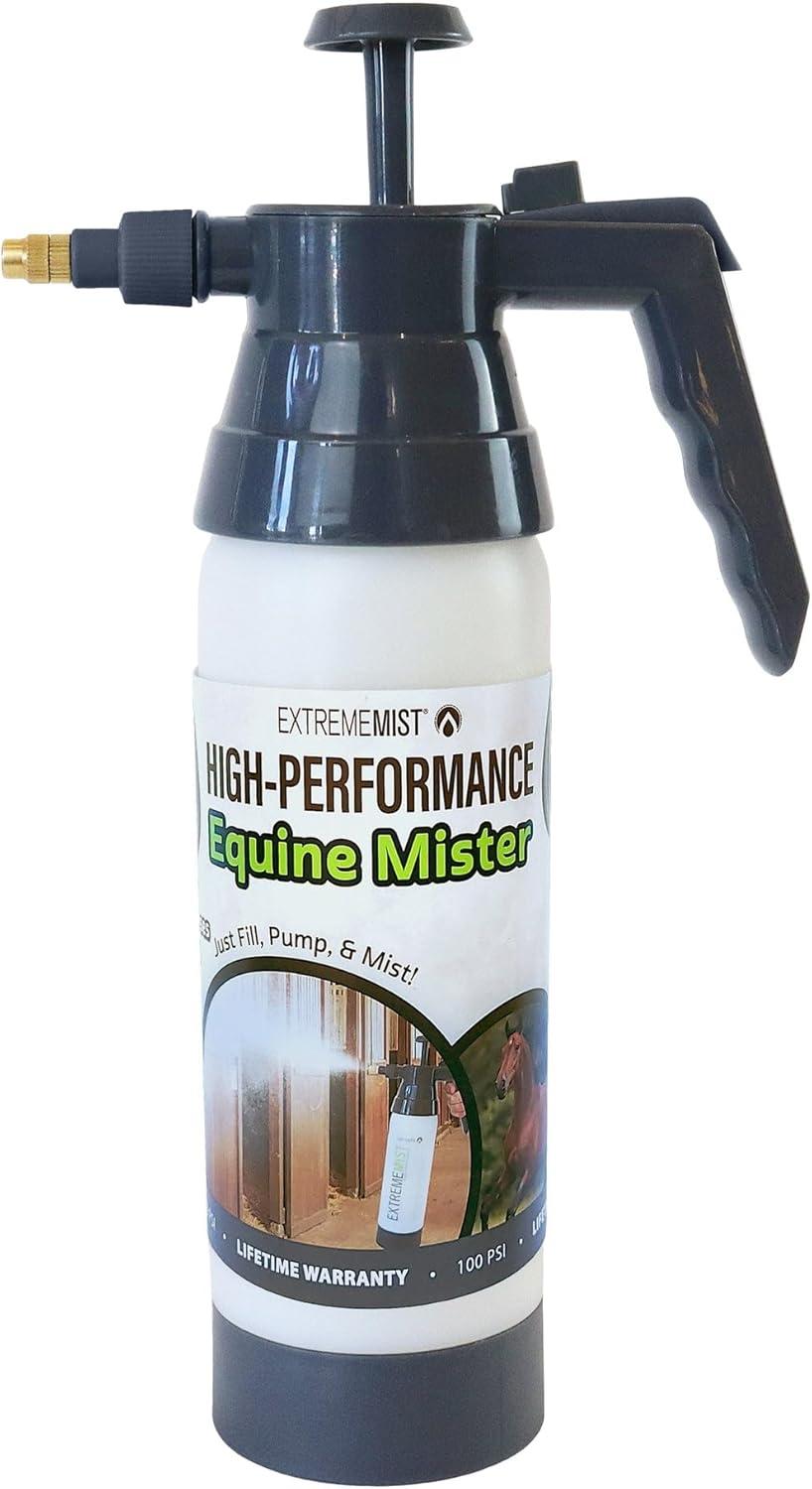
Fluval Bug Bites Bottom Feeder Fish Food introduces a fresh approach to feeding small to medium-sized bottom-dwelling fish through a carefully crafted, insect-based formula. Designed primarily for species such as plecos and ancistrus, this 1.60 oz. granule food prioritizes natural dietary habits by featuring Black Soldier Fly Larvae (BSFL) as its #1 ingredient. BSFL, sustainably farmed on fruits and vegetables, serve as a nutrient-dense “superfood” source, rich in high-quality protein and healthy fats—emulating the insects bottom feeders naturally seek in the wild.
Beyond BSFL,the formulation is enhanced with additional protein sources including herring and shrimp meal,contributing valuable Omega-3 and Omega-6 fatty acids. These nutrients support vibrant coloration, healthy skin, and resilient scales and fins. The granules sink slowly, aligning perfectly with the feeding behaviour of bottom dwellers, ensuring minimal waste and maximal nutrient uptake.
Manufactured with a commitment to freshness and quality, Bug Bites are produced in small batches using ingredients sourced close to the production facility in Canada. This close control over the supply chain guarantees the fish food retains its natural palatability without relying on artificial fillers, colors, or preservatives. The inclusion of essential vitamins, amino acids, minerals, and trace elements rounds out the profile to deliver balanced nutrition for daily feeding.
| Feature | Details |
|---|---|
| Primary Ingredient | Black Soldier Fly Larvae (up to 40%) |
| Additional Protein Sources | Herring Meal, Shrimp Meal |
| Nutrition Focus | High protein, Omega-3 & Omega-6 fatty acids, vitamins, minerals |
| Granule Size | 1.4 - 1.6 mm sinking granules |
| Target Species | Plecos, ancistrus, and other small to medium-sized bottom feeders |
| Packaging Size | 1.60 oz (45 g) |
| Manufactured | Canada |
| Artificial Additives | None (No fillers,colors,or preservatives) |
In practical use,aquarists often find that bottom feeders readily accept Bug Bites,drawn by the natural insect aroma and texture. Feeding sessions tend to be less wasteful, as the sinking granules descend to the substrate efficiently, minimizing disruption of water clarity. This product supports routine feeding schedules, with the recommended regimen being two to three times daily, allowing fish to consume the available food within two minutes to maintain water quality and fish health.
Switch to Healthier Ingredients for Your Bottom Feeders
Elevate your aquarium feeding routine with Fluval Bug Bites Bottom Feeder Fish Food. Harness the power of sustainable insect protein and premium marine nutrients to promote natural growth and vibrant health for your bottom dwellers. Order now on Amazon and see the difference in your aquatic ecosystem.
Unique Insect-Based Nutrition and Ingredient Quality
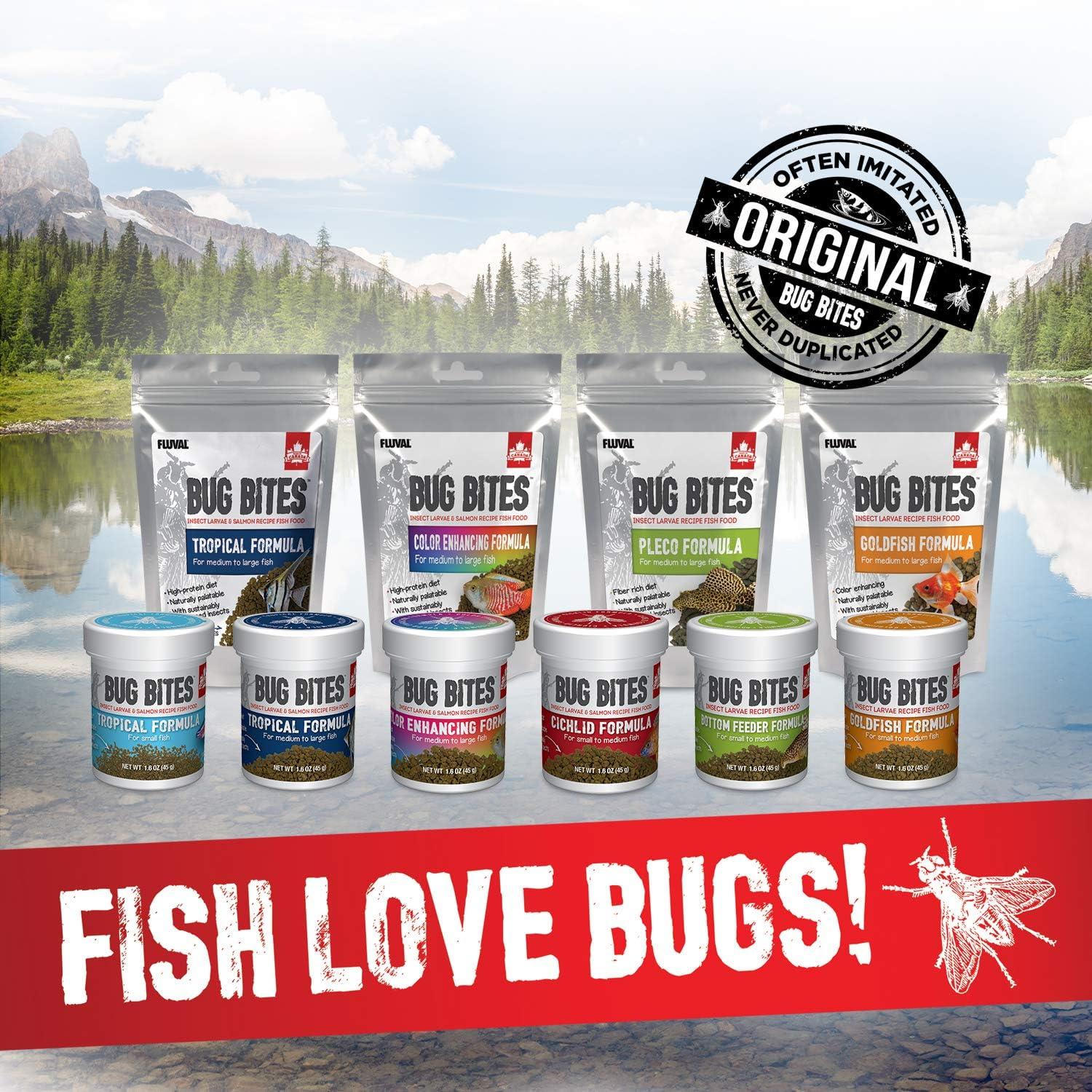
The Fluval Bug Bites Bottom Feeder Fish Food is distinguished by its innovative use of insect-based nutrition, a departure from conventional fish food formulas. At the heart of this recipe is the Black Soldier Fly Larvae (BSFL), sustainably harvested and serving as the primary ingredient, composing up to 40% of the formula. This unique protein source naturally aligns with the dietary habits of omnivorous freshwater fish, such as plecos and ancistrus, who instinctively forage for insects in their native habitats.
Unlike generic insect meals, the BSFL in Bug Bites are cultivated under carefully controlled conditions, fed exclusively on fruits and vegetables. This not only ensures sustainability but also enhances the nutritional profile, turning the larvae into a “super food” dense in high-quality protein and beneficial fats. The process involves a short, two-week growth cycle where larvae convert decaying plant matter into concentrated nutrients before being harvested and dried.
To complement the insect base, Bug Bites include additional protein sources such as Herring and Shrimp Meal, both rich in Omega-3 fatty acids. These ingredients contribute to healthier skin, vibrant scales, and robust fins, addressing both the dietary needs and aesthetic vitality of bottom-dwelling species.
| Key Ingredient | Role | Nutrition Highlights |
|---|---|---|
| Black Soldier Fly Larvae | Primary protein source | High in protein, healthy fats; sustainable and natural |
| Herring Meal | Secondary protein | Rich in Omega-3, supports skin and fin health |
| Shrimp Meal | Additional protein & flavor | Enhances palatability; provides essential amino acids |
| Vegetable-based feed | Nutrient conversion medium for larvae | Source of natural vitamins and fiber |
Aside from the nutrient-dense insect and marine proteins, the formula is fortified with essential vitamins, amino acids, minerals, and trace elements. This balance ensures complete nutrition,addressing everything from growth to immune function. The granule form, sized between 1.4 and 1.6 millimeters, is optimized for bottom feeders, minimizing waste and encouraging natural foraging behavior.
One of the most notable aspects of Fluval Bug Bites is its commitment to quality control, with each batch produced on a small scale to maintain ingredient freshness and dietary potency. Ingredients are sourced locally when possible, arriving just prior to production to maximize the granules’ appeal and digestibility for fish. The absence of artificial fillers, colors, or preservatives reinforces the product’s premium quality and suitability for sensitive aquatic species.
In practical terms, users may observe increased activity and natural feeding behaviors from their bottom feeders, as the formula mirrors the insects those fish would target in the wild. This alignment between nature and nutrition supports overall health and longevity.
Switch to Healthier Ingredients for Your Bottom Feeders
Elevate your aquatic pet’s diet with a formula inspired by nature’s own food chain. Experience the benefits of sustainable insect-based nutrition that promotes vibrant color, vitality, and balanced growth.
Benefits of Black Soldier Fly Larvae as the Primary Protein Source
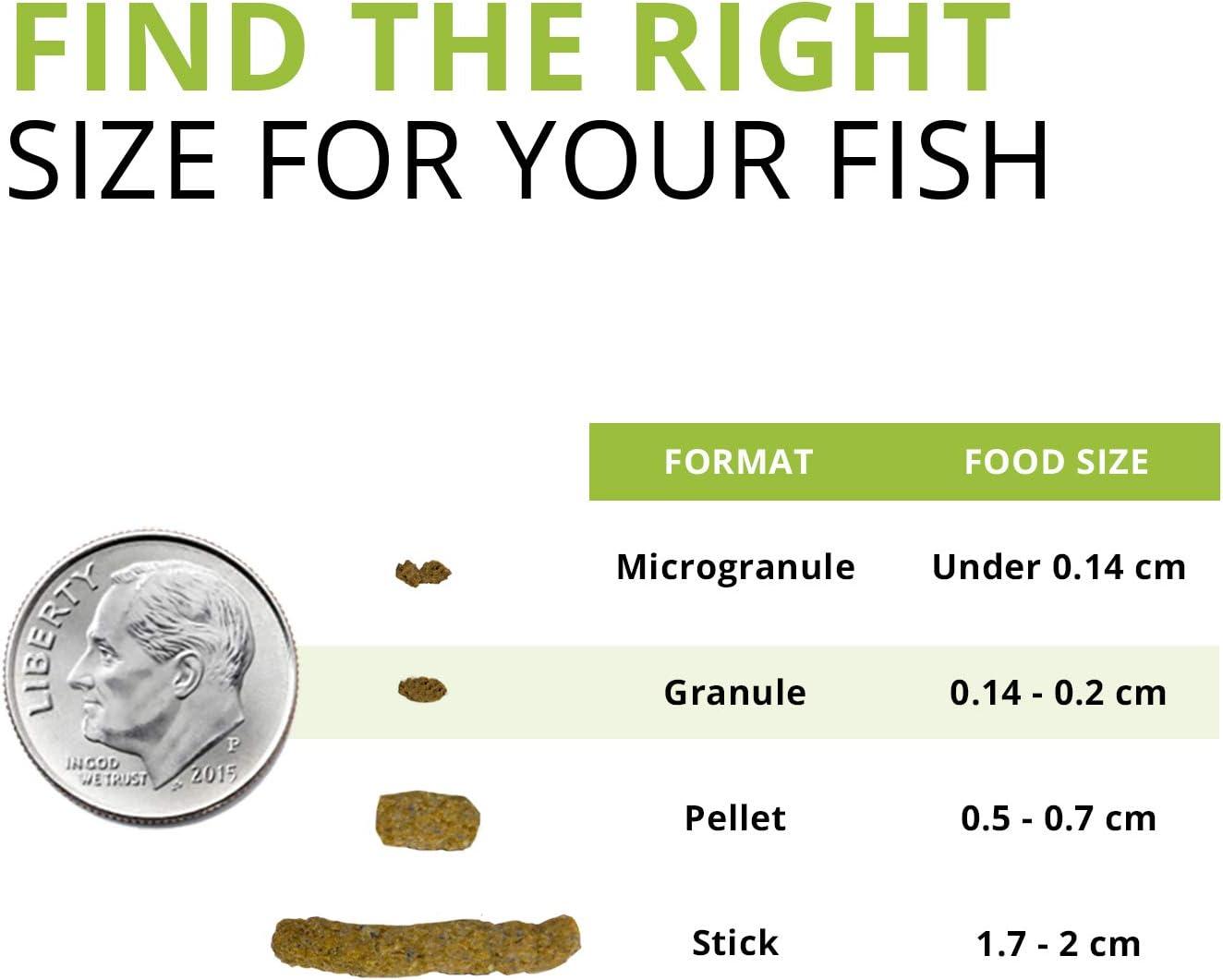
Black Soldier Fly Larvae (BSFL) serve as the cornerstone protein source in Fluval Bug Bites Bottom Feeder Fish Food, and for good reason. Known for their extraordinary nutritional profile, BSFL deliver a dense and highly digestible protein that closely mimics the natural diet of many bottom feeders such as plecos and ancistrus.These larvae are rich in essential amino acids, healthy fats including omega-3 and Omega-6 fatty acids, and vital micronutrients, making them a “superfood” choice that supports strong growth, vibrant coloration, and overall vitality.
Unlike traditional fish food proteins derived from man-made or heavily processed sources, BSFL are sustainably farmed on fruits and vegetables through a carefully controlled cultivation process. This natural feed conversion not only reduces environmental impact but also results in larvae that concentrate nutrients efficiently,turning plant waste into premium animal protein. The sustainable harvesting of BSFL ensures minimal strain on wild fish stocks and maintains ecological balance without compromising quality.
- Highly digestible protein: BSFL’s protein content enhances absorption and reduces waste, promoting better water quality in aquariums.
- Rich in Omega fatty acids: These contribute to healthy skin, fins, and scales, which is particularly beneficial for ornamental bottom dwellers.
- Source of natural fiber: Fiber from the larvae aids digestion and supports gut health, an often-overlooked factor in fish nutrition.
- Environmentally sustainable: BSFL farming uses organic waste streams, lowering the carbon footprint compared to traditional fishmeal sources.
- Palatability and instinctive feeding: Insects are instinctive prey for many freshwater species, so incorporating BSFL encourages natural feeding behaviors, reducing stress.
| Characteristic | Black Soldier Fly Larvae | traditional Fishmeal |
|---|---|---|
| Protein Quality | Complete amino acid profile, high digestibility | Variable quality, often less digestible |
| Omega fatty Acids | Rich in Omega-3 and Omega-6 | Lower levels, dependent on source |
| Sustainability | High, cultivated on organic waste | Low, often sourced from overfished stocks |
| Feed Conversion | Efficient nutrient conversion from plants to protein | Dependent on wild capture or farming practices |
| Impact on Water Quality | Lower waste output due to digestibility | Higher waste, could contribute to water fouling |
In real-world aquarium settings, many hobbyists report that bottom feeders readily accept Bug Bites’ BSFL-based formula, showing increased enthusiasm during feeding times. The sinking granule format combined with nutrient-dense larvae closely replicates the natural foraging habits of these fish, leading to better intake and less leftover food. This can result in a cleaner tank environment and healthier fish over the long term.
By focusing on Black Soldier Fly Larvae as the primary protein source, Fluval Bug Bites not only caters to the specific dietary needs of bottom feeders but also addresses broader ecological and sustainability concerns, making it both a responsible and effective choice for aquatic enthusiasts.
Switch to Healthier Ingredients for Your Bottom Feeders
Experience the power of nutrient-rich Black soldier Fly Larvae and give your plecos and ancistrus a diet that’s closer to nature. With Bug Bites, freshness and sustainability come together to nourish your fish from the bottom up.
Nutritional Profile: Proteins, Omega Fatty Acids, Vitamins, and Minerals
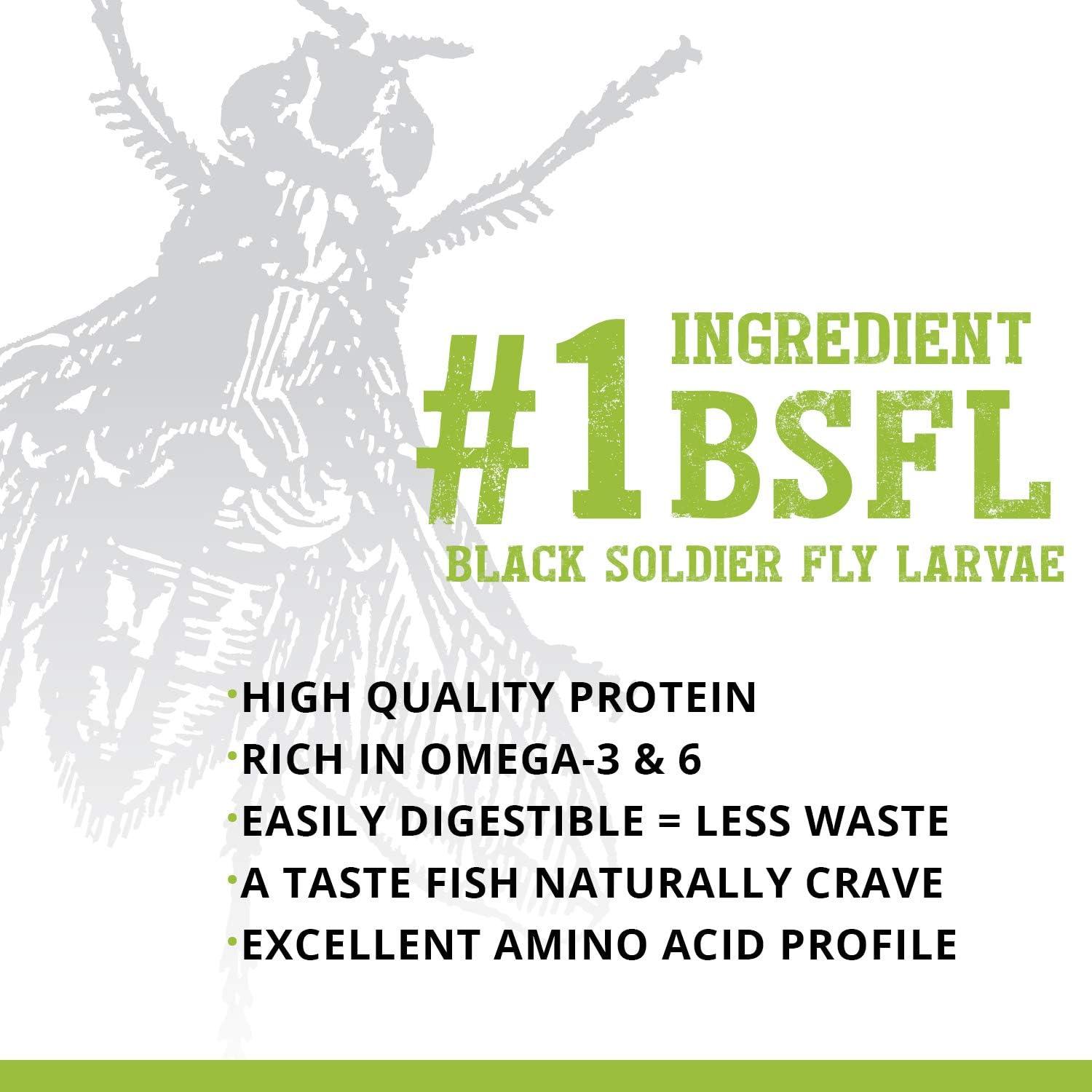
Fluval Bug Bites bottom Feeder Fish Food stands out with its thoughtfully crafted nutritional profile, designed to meet the unique dietary needs of small to medium-sized bottom-feeding fish such as plecos and ancistrus. At the core of its formulation is a high concentration—up to 40%—of nutrient-dense Black Soldier Fly Larvae (BSFL), which serves as an exceptional source of multiple proteins. This insect-based protein mirrors the natural prey of many freshwater fish, supporting instinctual feeding behaviors while delivering a complete spectrum of amino acids essential for growth and tissue repair.
Complementing the insect protein are quality marine proteins including herring and shrimp meal, which enrich the formula with valuable Omega-3 and Omega-6 fatty acids. These polyunsaturated fats are critical for maintaining vibrant coloration, healthy skin, resilient scales, and strong, unblemished fins. In a practical sense, feeding your fish with bug Bites can help minimize common issues such as dullness or fin fraying, often linked to poor fatty acid intake.
Beyond proteins and fats, the formula is fortified with a balanced array of vitamins and minerals tailored for a bottom feeder’s health. Essential vitamins such as A, C, D, and various B-complex groups support immune function, metabolic processes, and overall vitality. Meanwhile, key minerals and trace elements—calcium, phosphorus, zinc, and iron—play a vital role in skeletal progress, enzymatic reactions, and oxygen transport.The inclusion of fiber from vegetable sources also aids digestion and nutrient absorption, promoting consistent feeding and reducing waste buildup in your aquarium substrate.
| Nutrient | Source | Function |
|---|---|---|
| Proteins (40%+) | Black Soldier Fly Larvae, Herring & Shrimp Meal | Growth, tissue repair, amino acid supply |
| Omega-3 & Omega-6 Fatty Acids | Marine meals, insect larvae | Skin, scale, fin health, coloration |
| Vitamins (A, C, D, B-complex) | Fortified mix, natural ingredients | Immune support, metabolism, vitality |
| Minerals & Trace Elements | Calcium, phosphorus, zinc, iron | Skeletal structure, enzymatic function, oxygen transport |
| Fiber | Vegetable-based ingredients | Digestive health, stool consistency |
In real-world aquarium settings, the sinking granule format between 1.4 to 1.6 mm ensures that the food reaches bottom dwellers effectively without lingering on the surface, reducing waste and maintaining water clarity. Fish owners often report improved feeding engagement, as the natural insect aroma and fresh ingredient profile of Bug Bites align closely with bottom feeders’ instinctual eating habits. This not only supports consistent feeding routines but also helps maintain a balanced and vibrant aquatic environment.
Switch to Healthier Ingredients for Your Bottom Feeders
Experience the difference of an insect-inspired diet designed to nourish your plecos and ancistrus naturally. Bug Bites offers premium proteins, vital fatty acids, and a vitamin-rich profile that supports lasting fish health and aquarium vitality.
Suitability for Bottom Feeders: Plecos, Ancistrus, and Similar Species

Fluval Bug Bites Bottom Feeder Fish Food is specifically formulated to meet the dietary needs of plecos,ancistrus,and other similar bottom-dwelling species. Its sinking granule format, sized between 1.4 and 1.6 mm, ensures the food easily reaches the aquarium floor, mimicking the natural feeding behavior of these fish.This aspect is crucial because bottom feeders rely on substrates for nourishment, and floating or slowly sinking foods often end up wasted or uneaten.
The standout ingredient,sustainably harvested Black Soldier Fly Larvae (BSFL),constitutes up to 40% of the formula. This insect protein closely resembles the larvae and detritus that plecos and ancistrus would forage in the wild, making it highly palatable and instinctively attractive to these species. Additionally, BSFL provides excellent nutritional benefits with a rich profile of protein and healthy fats, supporting growth and enhancing skin, scale, and fin condition.
Complementing the insect base are whole salmon meal, herring, and shrimp meals, which boost the protein diversity and introduce beneficial Omega-3 and Omega-6 fatty acids. this blend supports the vibrant coloration many hobbyists seek in plecos and ancistrus, as well as the robust immune function and overall vitality of these fish. Moreover, the presence of vegetables and fiber helps replicate their omnivorous diet by aiding in digestion and gut health.
| Feature | Details | Benefit for Bottom Feeders |
|---|---|---|
| Sinking Granule Size | 1.4 - 1.6 mm | Ensures food reaches the aquarium bottom promptly |
| Main Protein source | Black Soldier Fly Larvae (40%) | Highly digestible insect protein resembling natural diet |
| Additional Proteins | Salmon, Herring & Shrimp Meal | Supports color, skin, immune system, and overall health |
| Vitamins & minerals | Fortified with essential vitamins, amino acids, minerals | Promotes balanced nutrition and vitality |
| Processing | Small batch, made in Canada with no artificial fillers | Fresh quality control ensures palatability and nutrient retention |
In practical terms, aquarists have noted that fluval Bug Bites are eagerly consumed by a variety of bottom feeders. Plecos,especially smaller-medium species and Ancistrus catfish,respond well to this diet,often showing increased activity and coloration soon after feeding. Because the granules sink rapidly and do not cloud the water, the feeding experience is clean and efficient. the controlled small-batch production guarantees freshness that often makes a visible difference compared to generic brands — leftovers are minimal,which reduces water fouling and maintenance.
Fluval Bug Bites Bottom Feeder Fish Food aligns closely with the natural feeding habits and nutritional demands of plecos and ancistrus, delivering an organic, insect-rich, and wholesome diet that supports their health without compromising water quality or sustainability.
Switch to Healthier Ingredients for Your Bottom Feeders
Give your plecos and ancistrus the nutrient-rich diet they instinctively crave. Experience the difference with Fluval Bug Bites’ sustainable, protein-packed formula.
Sinking Granule Format and Feeding Guidelines
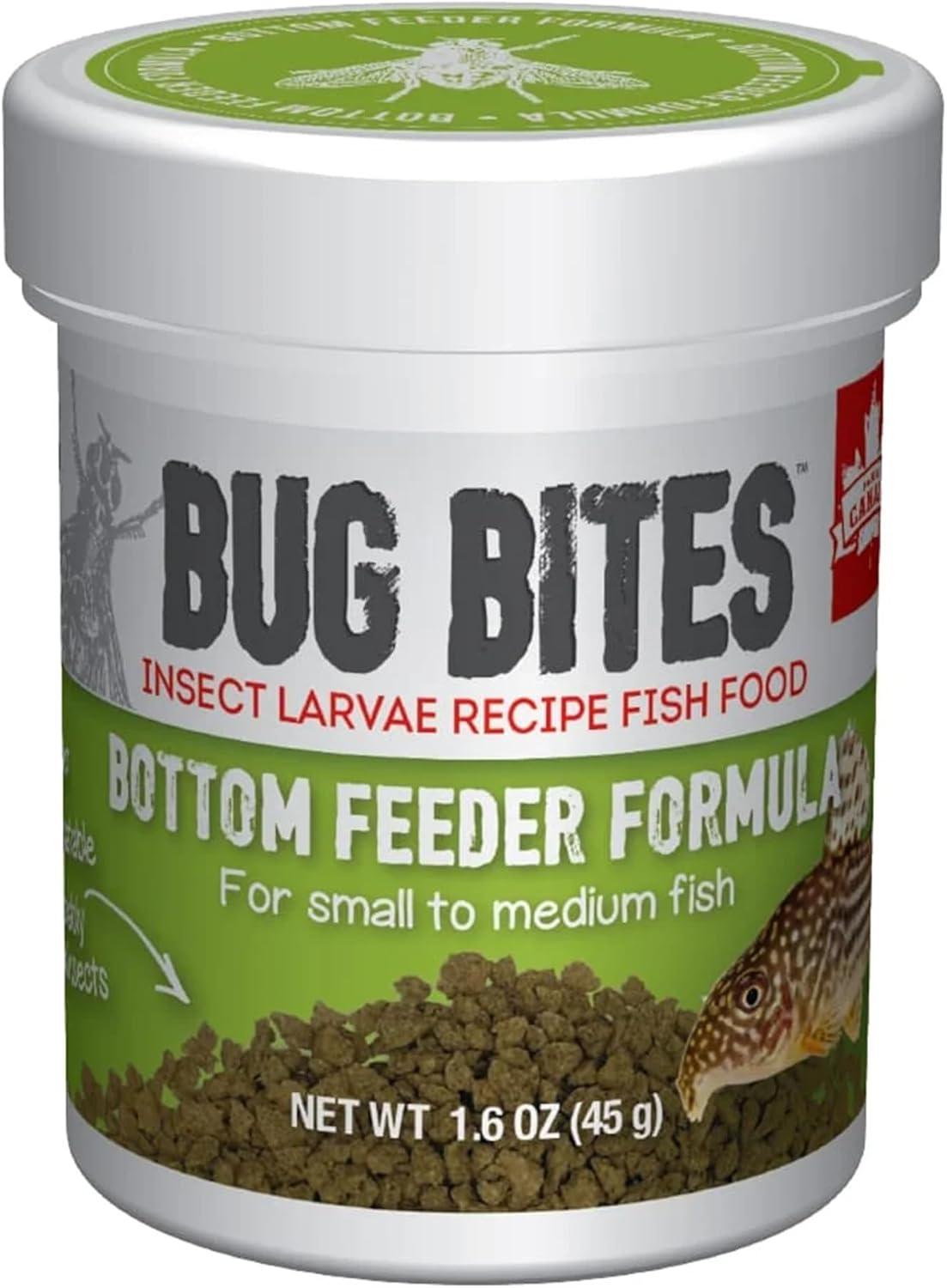
Fluval Bug Bites Bottom Feeder Fish Food comes in a carefully calibrated sinking granule format, sized between 1.4 and 1.6 millimeters. This size is specifically tailored to reach the substrate quickly without disintegrating, ensuring bottom-feeding species like plecos and ancistrus can easily access their meal. The granules’ slow-sinking nature simulates natural feeding behaviors, allowing fish to instinctively forage along tank surfaces just as they would in the wild.
The sinking granules are crafted from a nutrient-rich insect-based formulation, with Black Soldier Fly larvae as the primary ingredient. Combined with protein sources such as herring and shrimp meal, these granules provide not only a balanced macronutrient profile but also rich omega fatty acids that promote healthy skin, vibrant scales, and strong fins. the texture and composition also minimize waste and maintain water quality, which is crucial in a closed aquarium environment.
| Specification | Details |
|---|---|
| Granule Size | 1.4 – 1.6 mm sinking granules |
| Primary Protein | Black Soldier Fly Larvae (40%) |
| Additional Protein Sources | Herring & Shrimp meal |
| Feeding Frequency | 2 to 3 times daily |
| Feeding Amount | As much as fish can consume in 2 minutes |
| Production | Sustainably processed in small batches |
For optimal feeding,it is recommended to offer portions that your bottom feeders can consume within two minutes,two to three times per day.This approach prevents overfeeding, reducing uneaten pellets that could degrade water quality. Observing your fish’s behavior during feeding periods will help you adjust the quantity accordingly—active bottom feeders often show noticeable interest, quickly picking apart the sinking granules.
In a typical community tank, these granules sink evenly and remain intact long enough for all bottom dwellers to access their meal without competition from mid- or surface-feeders. This ensures species with specialized diets receive adequate nutrition without interference, contributing to a balanced, healthy ecosystem within the tank.
Fluval’s commitment to fresh, small-batch production also means these granules retain their palatability and nutritional value over time, a subtle but valuable benefit when ensuring consistent feeding success. The absence of artificial fillers or preservatives gives aquarists peace of mind that what goes into the tank supports long-term fish health.
Switch to Healthier Ingredients
Elevate your bottom feeders’ diet with a natural, sustainably sourced formula that supports their instinctive feeding habits. Try Fluval Bug Bites Bottom Feeder Fish food today for nutrition designed from the bottom up.
Sustainability and Ethical Production Practices
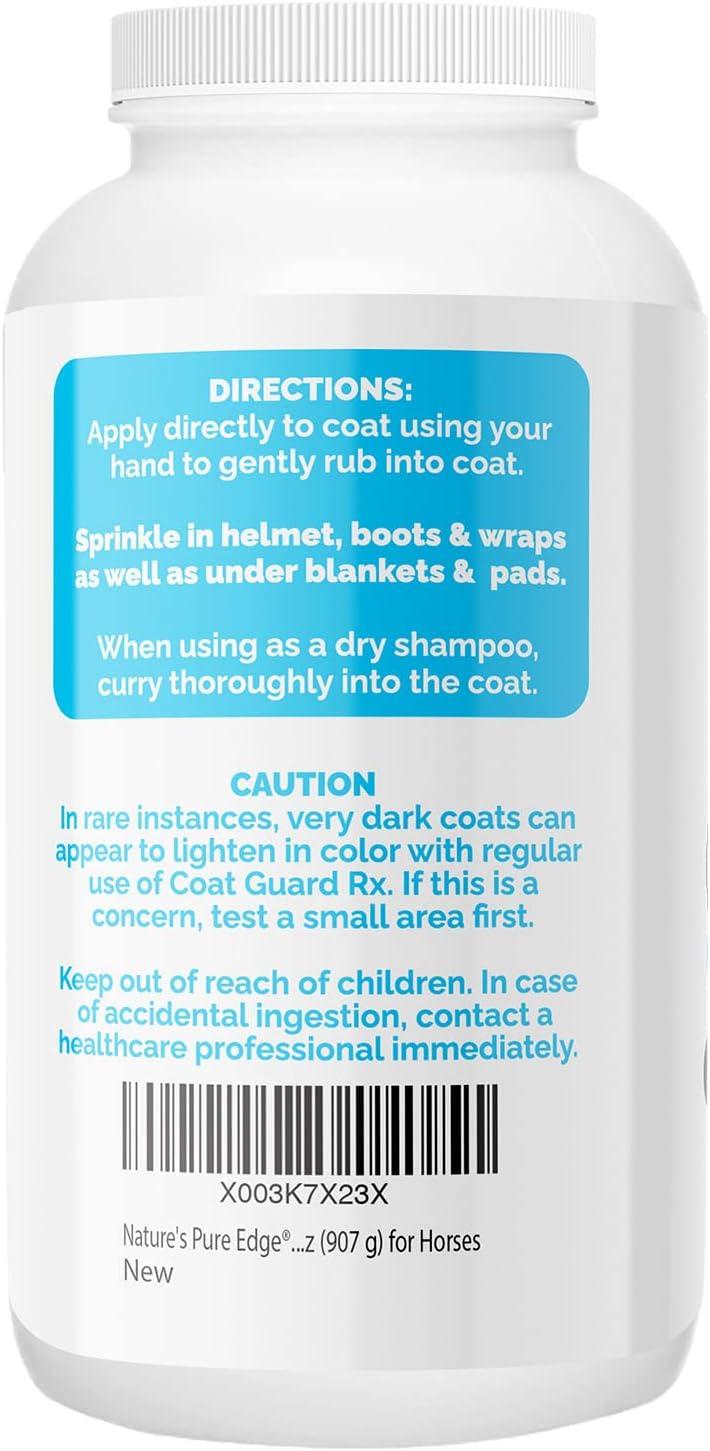
Fluval Bug Bites Bottom Feeder Fish Food stands out in the aquatic nutrition space not only for its innovative insect-based formula but also for its commitment to sustainability and ethical production. Central to its eco-conscious profile is the use of Black Soldier Fly Larvae (BSFL)—a highly nutritious, protein-rich ingredient that forms up to 40% of the formulation. Unlike traditional fish meal sources that often strain wild fisheries, BSFL are cultivated under strictly controlled, sustainable conditions in Canada, turning organic byproducts like discarded fruits and vegetables into high-quality nutrients through natural larval digestion.
This circular approach to ingredient sourcing minimizes environmental impact by reducing waste and limiting overfishing pressures, effectively mimicking the natural diet of many plecos and ancistrus species without compromising wild ecosystems. The larval cultivation relies on a two-week feeding cycle with no artificial additives, ensuring a clean, nutrient-dense protein source that aligns with responsible aquaculture principles.
Beyond the insect larvae, Bug Bites incorporates other ethically sourced, high-quality proteins such as herring and shrimp meals, both rich in Omega-3 fatty acids, vital for fish health. These ingredients are procured with attention to traceability and freshness, emphasizing minimal filler use and small-batch production to maintain quality and reduce waste. This careful,scaled manufacturing process also allows for closer monitoring of supply chains and lowers carbon footprints compared to mass-produced alternatives.
| Aspect | Fluval bug Bites Bottom Feeder Food | Typical Fish Food |
|---|---|---|
| Primary Protein Source | Black Soldier Fly Larvae (sustainably farmed) | Fish meal from wild-caught sources |
| Additional Proteins | Herring & Shrimp Meal, rich in Omega-3 | Varies; frequently enough less traceable |
| Production Scale | Small batches for freshness & quality control | Large-scale, mass production |
| Ingredient Freshness | Ingredients delivered just prior to blending | Variable; sometiems prolonged storage |
| Use of Fillers/ Preservatives | None; no artificial fillers, colors, or preservatives | Often contains fillers, artificial colors, preservatives |
From a practical perspective, using Bug Bites feels like a conscientious choice for aquarists wanting to align their hobby with ecological duty. It supports a more sustainable food chain that mimics natural feeding behaviors without sacrificing the nutritional needs of bottom feeder fish. For enthusiasts balancing care quality and environmental concerns, this brand offers a reliable middle ground.
Switch to Healthier Ingredients
Give your bottom feeders a nutrient-packed diet that’s as kind to the planet as it is to your fish. experience fresh, sustainable nutrition with fluval Bug Bites.
Freshness and Small Batch Quality Control
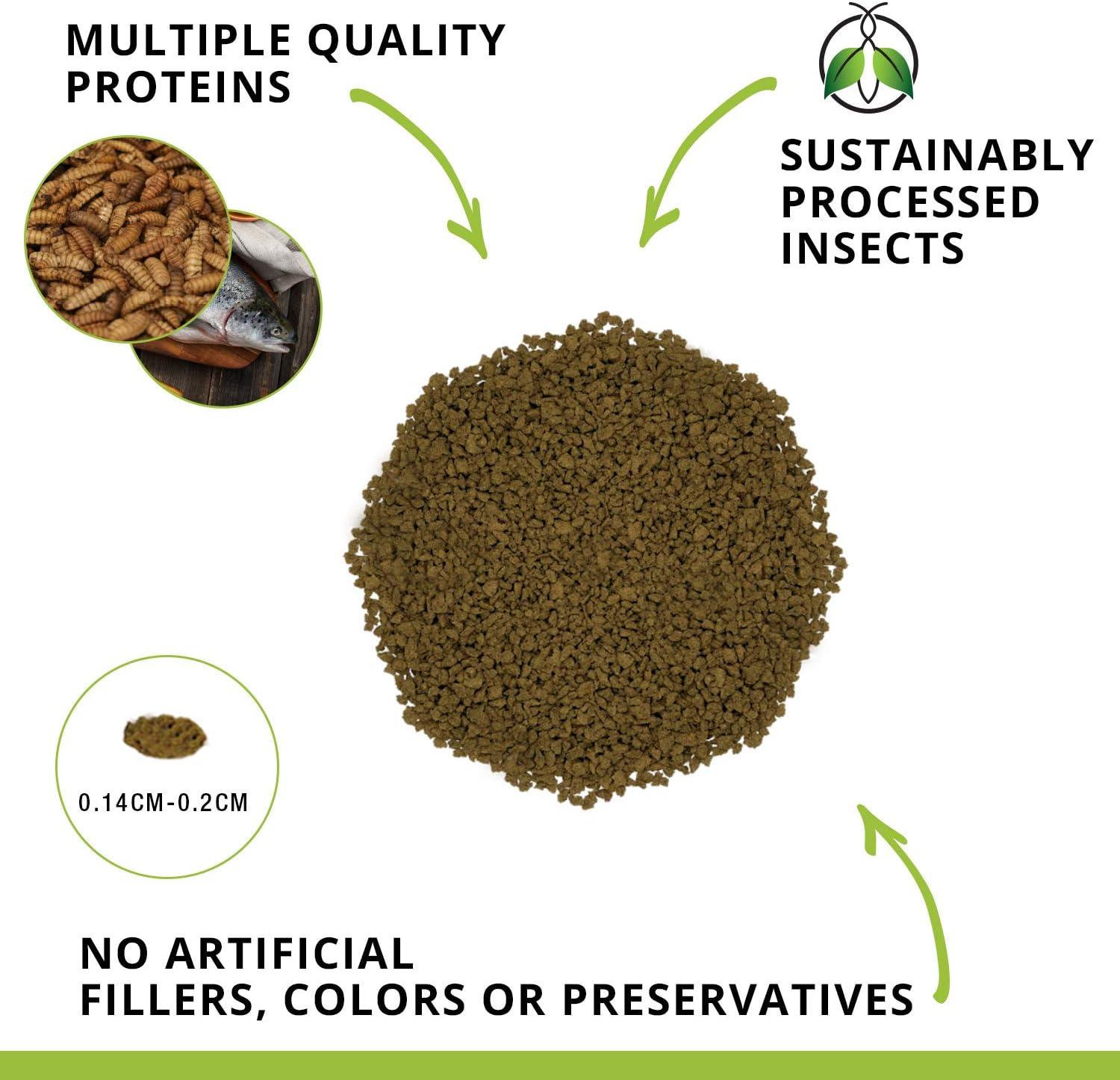
Fluval Bug Bites Bottom Feeder Fish Food is distinguished by its commitment to freshness and meticulous small batch quality control. Unlike many mass-produced fish foods that sit on shelves for extended periods, these granules are produced in limited quantities to maintain optimal nutrient integrity and palatability. This approach ensures that each batch delivers consistent quality, giving your bottom feeders the freshest possible meal rich in natural proteins and essential nutrients.
The unique insect-based formula relies heavily on Black Soldier Fly Larvae (BSFL), sustainably farmed under controlled conditions to preserve their nutritional profile. Thanks to the proximity of ingredient sourcing—often arriving shortly before production—Fluval minimizes the time between raw material delivery and the final packaging. This rapid turnover reduces nutrient degradation, which often occurs with conventional fish foods stored in bulk.
By focusing on small batch production, Fluval also allows for stringent quality checks at every stage. This means each batch undergoes comprehensive evaluation to ensure that the granules maintain their sinking properties, nutrient density, and attractiveness to finicky bottom feeders such as plecos and ancistrus. The result is a food that not only appeals to natural feeding instincts but also supports long-term fish health through stable delivery of proteins, vitamins, and minerals.
| Feature | Benefit | Impact on Fish Health |
|---|---|---|
| Small batch Production | Enhanced quality control and consistency | Reduces risk of nutrient loss, ensuring balanced diet |
| Freshly Sourced Ingredients | Minimized time from harvest to feed | maximizes palatability and nutrient retention |
| controlled BSFL Farming | Sustainable and nutrient-rich larval source | promotes natural feeding behavior with superior protein |
| No Artificial Fillers or Preservatives | Pure formulation | Reduces exposure to unneeded chemicals, supporting immunity |
In practical terms, this translates to a product that remains fresh longer after opening, giving aquarists confidence that their fish are getting peak nutrition every feeding.The sinking granules maintain integrity without breaking down quickly, offering both convenience and superior feeding satisfaction. Observant hobbyists will notice improved activity and coloration in their bottom feeders—a testament to the food’s quality and freshness.
Switch to Healthier Ingredients for Vibrant Bottom Feeders
Give your bottom feeders the nutritious edge they deserve with Fluval Bug Bites. Crafted with fresh, sustainable ingredients and small batch care, this fish food brings nature’s best right to your aquarium.
Comparing Bug Bites with Conventional Fish Foods
When placing Fluval Bug bites bottom Feeder Fish Food side-by-side with conventional fish foods,several distinctive differences emerge that highlight its unique approach to bottom feeder nutrition. Traditional fish foods often rely on plant-based fillers or generic protein sources that may lack the full spectrum of nutrients tailored to species like plecos, ancistrus, and other bottom dwellers. In contrast, bug Bites embraces an insect-based formulation centered around sustainably harvested Black Soldier Fly Larvae (BSFL), which compose up to 40% of the product’s ingredients. This focus not only offers a nutrient-dense, natural protein source but also closely mimics the wild diet of many bottom-feeding fish, tapping into their instinctive feeding behaviors.
Conventional sinking pellets or granules tend to contain artificial fillers, colors, and preservatives to extend shelf life and appeal visually.Bug Bites, however, avoids these additives, instead emphasizing freshness and quality by preparing food in small batches shortly after ingredient delivery. This method helps preserve nutrient integrity while also enhancing palatability, which many aquarium enthusiasts have noticed encourages more enthusiastic feeding from finicky bottom feeders.
| Feature | Fluval Bug Bites | conventional Fish Foods |
|---|---|---|
| Main Protein Source | Black Soldier Fly Larvae (40%), Herring & Shrimp Meal | Generic fish meal, plant fillers, soy, wheat gluten |
| Nutrient Enrichment | Omega-3 & Omega-6, Vitamins, Minerals, Amino Acids | Variable; frequently enough supplemented with synthetic vitamins |
| Format | Sinking granules (1.4–1.6mm), ideal for bottom feeders | Varies: flakes, pellets, wafers, sinking/floating |
| Production | Small batches, controlled freshness, no preservatives | Mass-produced, longer shelf life, with preservatives |
| Sustainability | BSFL raised on fruits and vegetables under controlled conditions | Frequently reliant on industrial fish meal or plant crops |
| Artificial Additives | None | Often contains artificial colors and preservatives |
In practical terms, customers who switch to Bug Bites often report improved acceptability by their bottom feeder species, likely due to the closer match to natural diets and enhanced freshness. The use of insect larvae fits the omnivorous habits of most freshwater fish, providing a whole-food source of protein and healthy fats that support vibrant color, growth, and overall health. Additionally, the small, sinking granule size is perfectly suited to fish that dwell and forage along tank bottoms, limiting waste and keeping tanks cleaner.
While conventional fish foods may still satisfy the basic nutritional needs of many aquarium species and are frequently enough more widely available or less expensive, Bug Bites sets itself apart by integrating sustainable ingredients and a balanced formulation designed with bottom feeders specifically in mind.For aquarists committed to high-quality nutrition and environmental responsibility, this product represents a thoughtful alternative to standard options.
Switch to Healthier Ingredients for Your Bottom Feeders
Give your plecos and ancistrus a diet that mirrors their natural feeding habits—with nutrient-rich, sustainable protein that promotes health and vitality.
Packaging, Storage, and Shelf Life Considerations
The Fluval Bug Bites Bottom Feeder Fish Food is packaged in a compact, resealable pouch that measures just 2.3 x 2.3 x 2.8 inches and contains 1.60 ounces of nutrient-dense granules. This design makes it exceptionally easy to handle and store without occupying much space, an important feature for hobbyists with limited storage room or who maintain multiple aquariums.The resealable zipper helps maintain the product’s freshness by reducing exposure to air and moisture, which is crucial for preserving the integrity of the high-quality proteins and sensitive vitamins in the formulation.
Given that Bug Bites are produced in small batches with a focus on freshness—highlighted by the use of ingredient deliveries right before production—the packaging does not use heavy preservatives or artificial fillers. This natural approach means careful storage is imperative to extend shelf life and retain nutritional value.Users should store the pouch in a cool, dry place away from direct sunlight and humidity to prevent degradation of the insect larvae proteins and essential fatty acids like Omega-3 and Omega-6.
Even though the product’s exact shelf life is not explicitly stated on the packaging, typical dry fish foods sealed properly can last approximately 12 to 18 months. However, once opened, it is recommended to use the food within 2 to 3 months for optimal freshness and palatability, especially given the natural composition without synthetic preservatives. Keeping the pouch tightly sealed after each use reduces oxidation and the risk of moisture ingress, both of which can compromise the food’s quality.
Here is a speedy comparison of the packaging and storage characteristics of Fluval Bug Bites in relation to typical bottom feeder fish foods:
| Feature | fluval Bug Bites | Typical Commercial Bottom Feeder food |
|---|---|---|
| Package size | 1.60 oz resealable pouch | 3 to 8 oz tubs or bags |
| Packaging Type | Flexible pouch with zipper | Plastic jars or bulk bags, frequently enough no reseal |
| Preservatives | No artificial preservatives | Often contains preservatives to extend shelf life |
| Storage Recommendations | Cool, dry place; keep sealed | Cool, dry place; some require refrigeration after opening |
| Typical shelf Life After Opening | 2-3 months | 3-6 months depending on preservatives |
In practical use, many aquarists find that the small-batch, fresh approach offered by Bug Bites means the pouch size tends to align well with the feeding volume of moderate-sized plecos and ancistrus populations, reducing waste from extended exposure. The sinking granule format also minimizes floating residue, helping keep tanks cleaner over time. For those mindful of maintaining nutrient density and freshness, the pouch can be conveniently stored alongside other delicate small-batch fish foods and rotated regularly.
Switch to Healthier Ingredients
Elevate your bottom feeder’s diet by choosing a high-quality, sustainable formula designed for maximum freshness and nutritional impact. Experience the natural benefits of insect-based proteins and nourish your aquatic pets with superior care.
Customer Feedback and Overall Satisfaction
Fluval Bug Bites Bottom Feeder Fish Food has garnered a range of feedback from hobbyists and aquatic enthusiasts, highlighting its strengths in both formulation and effectiveness. Many users report noticeable improvements in their plecos’ and other bottom dwellers’ vitality and coloration after incorporating Bug Bites into their feeding routine. The insect-based formula, particularly the emphasis on Black Soldier Fly Larvae, resonates well with customers seeking a more natural and sustainable feeding option, reflecting their fish’s instinctive diet.
Several reviewers appreciate the sinking granule format, noting it minimizes waste by reaching the bottom of the tank quickly and attracting bottom feeders without dispersing too rapidly. This helps maintain cleaner aquariums and ensures that shy or nocturnal fish receive adequate nutrition. The small batch production and fresh ingredients also receive praise, with many users observing better palatability compared to more mass-produced alternatives.
having mentioned that, a handful of customers mentioned that some bottom feeders took a short adjustment period before fully accepting the new food, which is common when switching diets.A few also wished for larger package sizes given the feeding frequency, as the 1.60 oz container can require frequent re-purchasing for tanks with multiple or larger bottom feeders.
| Key Feature | Customer Insight |
|---|---|
| Protein Source (Black Soldier Fly Larvae) | Praised for being nutrient-rich and sustainable; enhances fish activity and color |
| Sinking Granules Size (1.4-1.6mm) | Ideal for small to medium bottom feeders; appreciated for reduced food waste |
| Production Quality | Small batches ensure freshness and consistent quality, favored by experienced aquarists |
| Packaging Size (1.60 oz) | Considered somewhat small for larger tanks or multiple fish, prompting frequent repurchases |
| Retention of Nutrients | Highly rated for maintaining vitamin and mineral content without fillers or preservatives |
Fluval Bug Bites achieves a positive reception by addressing the dietary needs of bottom feeders with a thoughtfully formulated, insect-based diet that closely mimics natural feeding behaviors. The product inspires confidence in fish health while supporting sustainable sourcing efforts. Consumers who prioritize ingredient openness, ecological responsibility, and nutrient-rich meals tend to express the highest satisfaction.For those managing a diverse community tank with bottom-dwelling species, Bug Bites stands out as a reliable and health-conscious option.
Switch to Healthier Ingredients for Your Bottom Feeders
Discover how Fluval Bug Bites can naturally improve your fish’s nutrition with sustainably sourced proteins and enriched vitamins. Shop now on Amazon and give your aquatic pets the diet they deserve.
Value for Price and Long-Term Health Benefits for Fish
The Fluval Bug bites Bottom Feeder Fish Food stands out in terms of value for price due to its innovative use of insect protein and a carefully balanced nutritional profile. At just 1.60 ounces per package, the price might initially suggest a premium product, but the quality and efficacy justify this investment. The granules are packed with up to 40% nutrient-rich Black Soldier Fly Larvae, which is not only sustainable but also closely matches the natural diet of many bottom feeders such as plecos and ancistrus. This thoughtful formulation ensures that your fish receive a high-protein meal that supports vitality without relying on artificial fillers or preservatives.
Investing in Bug Bites means choosing a food that focuses on long-term health benefits rather than short-term satiation. The inclusion of quality proteins such as herring and shrimp meal adds essential Omega-3 and Omega-6 fatty acids, which are crucial for maintaining healthy skin, vibrant scales, and resilient fins. Moreover, this blend provides a spectrum of vitamins, minerals, and amino acids that promote immune system strength and help prevent common nutritional deficiencies linked to poorer fish health over time.
| Feature | Bug Bites Bottom Feeder Food | Typical budget Food |
|---|---|---|
| Main Protein Source | Black soldier Fly Larvae (up to 40%) | Fish meal, plant-based proteins |
| Omega Fatty Acids | Rich in Omega-3 & Omega-6 | Limited, often no added Omegas |
| Formulation Type | Complete, balanced with vitamins and minerals | Basic nutrition, often lacking micronutrients |
| Batch Size & Freshness | Small batches for freshness | Mass-produced, longer shelf life but lower freshness |
| Artificial Additives | None (no fillers, colors, preservatives) | Often contains artificial colors and preservatives |
| Ideal For | Bottom feeders like plecos, ancistrus | General community fish foods |
The sinking granule size (1.4-1.6mm) is meticulously designed for bottom feeders’ feeding habits,ensuring minimal waste and cleaner tank conditions—a feature that adds indirect value by requiring less frequent cleaning and improving water quality over time. Because these foods are produced in Canada under strict quality controls and sustainable farming practices,users can feel confident in the ethical sourcing and consistent quality of every batch.
For the dedicated aquarist, Bug Bites offers peace of mind knowing their fish are receiving nutrition that closely replicates their natural diet, which can lead to reduced stress and enhanced longevity.While the upfront cost might be higher than standard mass-market foods, the health dividends seen in more vibrant coloration, sturdier fins, and enhanced appetite control provide exceptional return on investment over months and years of feeding.
Switch to Healthier ingredients for Your Bottom Feeders
Elevate your aquarium with Bug Bites—nutrient-rich, sustainably sourced black soldier fly larvae and premium proteins that promote long-lasting fish health.
Customer Reviews Analysis
Reading through numerous customer reviews,it’s clear that Fluval Bug Bites Bottom Feeder Fish Food has won the affection of many aquarium enthusiasts and their finned friends alike. The consensus leans heavily on the product’s effectiveness and appeal across a variety of bottom-dwelling species. From Cory catfish and albino catfish to mystery snails and shrimp, the protein-packed insect diet seems to spark enthusiasm and promote healthy populations.
Many users appreciate the food’s fast-sinking granules, which are perfectly sized for small to medium bottom feeders. This specific feature ensures that the intended fish get first dibs without leftover drifting pellets clouding the water or creating mess. Actually, numerous reviews highlight how the tank water stayed clear even after repeated feedings, a big plus for maintaining an attractive aquarium environment.
Another strong point from the customer feedback is the versatility of the product. not only bottom feeders but also Betta fish and other tropical species appear to enjoy the taste,which suggests broad palatability. There are multiple mentions of increased activity and better appetite among fishes following the switch to this insect-based diet. Some even report population boosts in snails and shrimp, hinting that Bug Bites might provide nutritional elements missing from more traditional algae wafers or fish-based foods.
On the affordability front, many users commented on the product’s excellent value. The portion size in each container consistently exceeded expectations,paired with a price point that fits well within most hobbyist budgets.
That said, the product isn’t without minor drawbacks.A few reviewers noted the presence of fine powder settling at the bottom when pinching out pellets, which can cause slight grime buildup on tank surfaces if not cleaned regularly. There’s also some feedback about pellet size being occasionally large for tiny species like Neon Tetras, leading to slower consumption or nibbling rather than full ingestion.
the food’s quality,effectiveness,and the positive impact on various bottom feeders clearly outweigh these minor concerns. Users are particularly impressed by how well their fish and invertebrates respond to the insect protein formula compared to more traditional options.
| Top Praises | Common Complaints |
|---|---|
| Highly palatable to diverse bottom feeders and tropical fish | Some powder residue settling in the container and tank |
| Fast-sinking pellets, preventing water clouding and waste | Pellet size occasionally too large for very small fish species |
| Encourages growth in snails, shrimp, and fish alike | Requires somewhat frequent tank cleaning to manage powder build-up |
| Affordable with generous container size | Ingredients may not appeal visually to some owners (but loved by fish!) |
For those seeking a nutritious, protein-rich diet that supports the natural feeding behaviors of bottom dwellers, Fluval Bug Bites is a compelling option.Its balance of quality, price, and fish approval makes it a worthy staple in many tanks.
Pros & Cons
- Rich in nutrient-dense black Soldier Fly Larvae, mimicking natural insect diets for bottom feeders.
- High-quality blend of proteins including whole salmon, herring, and shrimp meal, boosting Omega-3 and Omega-6 for vibrant skin and fins.
- Sinking granule size (1.4-1.6mm) perfectly designed for bottom-dwelling fish like plecos, Corys, and ancistrus.
- fortified with essential vitamins,amino acids,and minerals to support a balanced and healthy daily diet.
- Sustainably farmed ingredients and produced in small batches, ensuring freshness and superior quality control.
- No artificial fillers, colors, or preservatives, making it a clean and natural option for our aquatic friends.
- Excellent palatability—our bottom feeders absolutely love the taste and eagerly go after it.
- Improved tank ecosystem noticed, with positive effects on snails and shrimp populations alongside fish.
- Packaging is compact and easy to store, delivering great value for the price.
- fine powder residue can accumulate at the bottom, requiring more frequent tank cleaning to avoid grime buildup.
- Granule size might be slightly large for very small fish like neon tetras, who may struggle to eat them comfortably.
- Some powder dust may be released when dispensing, which can cloud the water briefly if overfed.
- Although high in insect-based proteins, the ingredient list might seem unappealing to some hobbyists despite its benefits to fish.
- Feeding recommendations require care—not to overfeed—to maintain optimal water clarity.
Take the Next Step
Buying through Amazon ensures secure checkout and quick delivery.
Q&A
What makes Fluval Bug Bites Bottom Feeder Fish Food different from other bottom feeder foods?
Fluval Bug Bites stands out because it features a unique insect-based formulation with up to 40% nutrient-rich Black soldier Fly Larvae as the first ingredient. This natural protein source, combined with high-quality proteins like whole salmon, herring, and shrimp meal, delivers essential Omega-3 and Omega-6 fatty acids for healthy skin, scales, and fins. Unlike many big-brand alternatives, Bug Bites are processed in small batches to ensure freshness, quality control, and superior palatability.
Is this food suitable for all types of bottom feeder fish?
Yes, Bug Bites are specially crafted for all types of plecos, ancistrus, and other small to medium sized bottom-dwelling fish. The sinking granules,sized between 1.4-1.6 mm, are ideal for bottom feeders’ natural feeding habits, making it easy for them to consume the right amount of nutrition.
how should we feed our fish with Bug Bites?
We recommend feeding as much as your fish can eat comfortably in two minutes, two to three times daily. Because the granules sink quickly, your bottom feeders can enjoy feeding at their own pace without the food dispersing too rapidly in the water.
Are the ingredients sustainably sourced?
Absolutely. The star ingredient—Black Soldier Fly Larvae—is sustainably harvested and raised on a diet of fruits and vegetables grown under controlled conditions.This sustainable process ensures minimal impact on natural environments while converting organic matter into a highly nutritious protein and fat source.
Does this product contain any artificial fillers, colors, or preservatives?
No, Bug Bites contains no artificial fillers, colors, or preservatives. The focus on natural, high-quality ingredients means we can provide a clean, wholesome diet that supports your fish’s health and vitality.
What benefits do the Omega-3 and Omega-6 fatty acids provide?
Omega-3 and Omega-6 fatty acids help maintain vibrant skin and scales, support fin health, and enhance natural coloration. Incorporating these essential fatty acids into daily nutrition promotes an overall healthier, more active fish.
Can Bug Bites be used as a complete daily diet?
Yes, Bug Bites are formulated as a complete fish food. They’re enriched with proteins, vitamins, minerals, amino acids, and trace elements that provide balanced nutrition for your bottom feeders every day.
How fresh is this food compared to other brands?
We love that Bug Bites are produced in small batches with ingredients delivered just before production. This approach ensures maximum freshness, which contributes to better taste and increased acceptance from even the pickiest bottom feeders.
Is this product appropriate for very young or juvenile fish?
Yes, the manufacturer recommends the food for fish aged 1 month and up, making it suitable for juveniles as well as adult fish.
Where is Fluval Bug Bites Bottom Feeder Fish Food made?
This fish food is proudly made in Canada, ensuring high manufacturing standards and a commitment to quality in every batch.
Transform your World
as we’ve seen, Fluval Bug Bites Bottom Feeder Fish Food truly stands out as a thoughtfully crafted, nutrient-rich option perfectly suited to the natural diets of our plecos, ancistrus, and other bottom dwellers. Thanks to its unique insect-based formulation featuring sustainably harvested Black Soldier Fly Larvae and a balanced blend of proteins, vitamins, and minerals, our fish have thrived with vibrant colors, healthy fins, and energetic behavior. The sinking granule format ensures food reaches the bottom where they naturally forage, making every feeding time rewarding for both our fish and us.
For those looking to provide their bottom feeders with a superior, protein-packed diet that honors their instinctive eating habits and supports long-term health, Bug Bites is definately worth considering. Small batch processing and the absence of artificial fillers only add to its appeal,promising freshness and quality in every bite. We’re excited to continue watching our fish flourish on this innovative food and hope our experience helps you make an informed choice for your own aquatic friends.
Ready to see how your bottom feeders respond to this impressive diet? check it out for yourself here: Fluval Bug Bites Bottom Feeder Fish Food on Amazon.
54 reviews for How Our Bottom Feeders Thrived on This Protein-Packed Insect Diet
Add a review Cancel reply
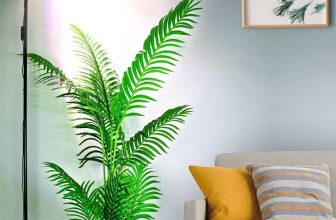
Top Aquarium Gear: Tanks, Lights, Filtration & More Reviewed
When it comes to creating the perfect aquatic environment, having the right gear can make all the ...
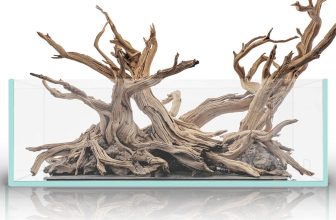
Top Rainbow Fish Care and Aquarium Kits for Every Hobbyist
When it comes to keeping rainbow fish—a vibrant, active species beloved by aquarists—having the ...
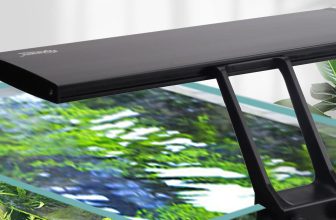
Top Aquarium LED Lights for Every Tank: Bright, Colorful & Customizable
When it comes to illuminating your aquatic world, the right LED light can transform your tank into ...





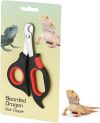
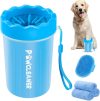

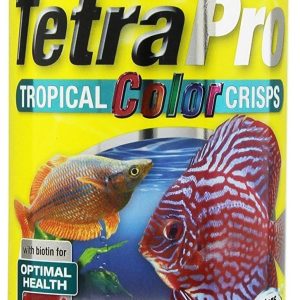
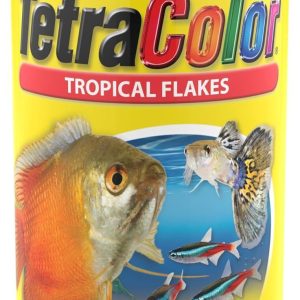
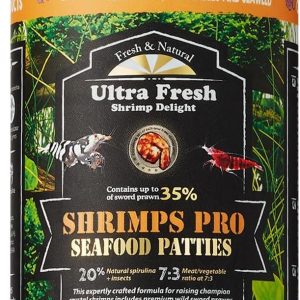
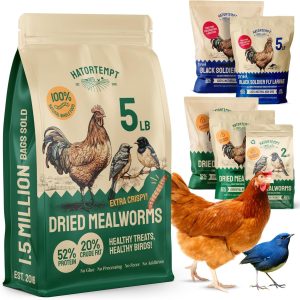
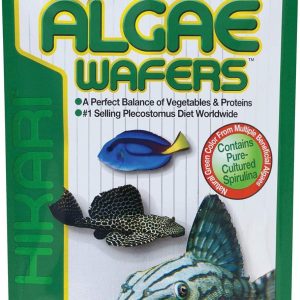

Chad Lewis –
This is fascinating! It’s amazing to see how alternative protein sources can support a diverse ecosystem and help bottom feeders thrive.
David Sullivan –
I never realized how much of an impact diet has on these creatures; it’s incredible to see bottom feeders adapting and thriving with such innovative food sources!
Lawrence Nelson –
I’ve always been intrigued by the resilience of bottom feeders, and it’s exciting to see them benefit from a diet rich in insects—this could really change our perspective on sustainable feeding practices!
Karen Hall –
It’s great to see these insights into the adaptability of bottom feeders; this research could open up new avenues for sustainable aquaculture and food systems!
Stanley Bryant –
Absolutely fascinating! It’s encouraging to learn how these adaptive strategies not only benefit bottom feeders but also promote sustainability in our food systems, proving that innovation in diet can have far-reaching positive effects.
Olivia Patterson –
This is such an enlightening topic! The idea that bottom feeders can thrive on an insect diet not only showcases their adaptability but also highlights the potential for transforming how we think about sustainable feeding practices in aquaculture.
Laura Taylor –
What an eye-opening discussion! I’m thrilled to see how embracing insect-based diets for bottom feeders can pave the way for more sustainable aquaculture practices and reduce our reliance on traditional feed sources!
Brittany Walker –
This discussion is truly inspiring! The successful integration of insect protein into the diets of bottom feeders not only enhances their growth but also promotes an eco-friendly approach to aquaculture, which is a win-win for both the industry and the environment!
Teresa Brooks –
I’m truly amazed by the potential of insect diets for bottom feeders! This approach not only maximizes their health and growth but also offers a sustainable solution to feed scarcity in aquaculture, showcasing the innovative future of our food systems.
Stanley Long –
It’s inspiring to see how bottom feeders are thriving on insect diets—this innovation not only enhances their overall health and growth but also represents a significant step towards more environmentally friendly practices in aquaculture, showcasing a promising future for sustainable food sources!
Edward Bailey –
It’s fascinating to witness how bottom feeders are thriving on insect-based diets; this not only promotes their health but also signifies a crucial advancement in aquaculture sustainability, potentially revolutionizing how we approach fish farming and food security!
Carol Wells –
Absolutely thrilled to see the positive impact of insect diets on bottom feeders! This innovative approach not only boosts their health and productivity but also highlights the shift towards more sustainable aquaculture practices, which is essential for the future of our food systems.
Bruce Murray –
This is a remarkable shift in aquaculture! I’m impressed by how incorporating insect protein into bottom feeders’ diets not only boosts their health and growth but also provides a sustainable solution that could greatly benefit our ecosystems and food systems in the long run.
Oscar Wallace –
Incredible to see the positive results from providing bottom feeders with insect protein! This could lead to a transformative change in aquaculture that promotes ecological balance while ensuring food security through sustainable practices.
Grace Nelson –
I’m so excited about the benefits that insect protein brings to bottom feeders! This innovative approach not only improves their well-being but also paves the way for sustainable aquaculture practices, ensuring a healthier ecosystem and better food sources for the future.
Judith Watson-Wright –
It’s inspiring to see how embracing insect protein for bottom feeders is leading to healthier fish and a more sustainable future for aquaculture; this innovative approach truly showcases the potential for positive environmental impact and food security!
John Harris –
This is such an exciting development in aquaculture! The way insect protein is enhancing the health of bottom feeders while promoting ecological sustainability is a game-changer for the industry and a crucial step towards more resilient food systems.
Abigail King –
I’m thrilled to see such innovative solutions in aquaculture! The use of insect protein for bottom feeders is a powerful step towards creating a more sustainable and eco-friendly food system, promoting both the health of our aquatic life and the health of our planet.
Mitchell Walker –
It’s fantastic to witness the innovative use of insect protein in aquaculture! This not only enhances the health of bottom feeders but also contributes to a more sustainable and efficient food system, proving that we can prioritize both marine life and environmental responsibility.
Leonard Cole –
I completely agree with the enthusiasm surrounding the use of insect protein in aquaculture! It’s encouraging to see how this sustainable practice not only enhances the health of bottom feeders but also contributes to a circular economy, reinforcing the connection between innovative food sources and ecological stewardship.
Clifford Brooks –
I’m really impressed by the potential of insect protein in aquaculture; it’s great to see how this approach not only supports the health of bottom feeders but also champions sustainable practices that could revolutionize the industry and benefit our ecosystems in the long run!
Virginia Wood –
I’m overjoyed to see the incredible benefits of insect protein for bottom feeders in aquaculture! This innovative approach not only supports the vitality of these species but also embodies a sustainable model that can lead us toward a more responsible and mindful way of interacting with our ecosystems.
Ethan Russell –
I’m excited to see the positive impact of an insect diet on bottom feeders! This strategy not only boosts their health but also underscores the importance of sustainable practices in aquaculture, paving the way for a brighter future for both our ecosystems and food sources.
Beverly Russell –
I’m thrilled to see the enthusiasm around insect protein for bottom feeders! This innovative approach not only supports their health and vitality but also sets a precedent for sustainable aquaculture practices that can help protect our planet’s resources and promote ecological balance.
Paul Green –
Absolutely love the growing trend of incorporating insect protein into the diets of bottom feeders! This not only enhances their growth and health but also highlights a crucial shift towards sustainable practices in aquaculture, fostering a healthier planet for future generations.
Denise Price –
I’m so encouraged by the growing recognition of insect protein for bottom feeders! This forward-thinking approach not only enhances their nutritional intake and well-being but also promotes sustainable aquaculture solutions that can significantly benefit both our environment and food security in the future.
Nathan Graham –
It’s inspiring to witness the impactful role of insect protein in the diets of bottom feeders! This progressive step not only enhances their overall health and growth rates but also champions sustainability in aquaculture, paving the path for a more eco-conscious future in our food systems.
Marilyn Roberts –
It’s fantastic to see the positive results from integrating insect protein into the diets of bottom feeders! This key development not only supports their health and growth but also emphasizes the crucial need for sustainable practices in aquaculture, fostering a greener future for our planet and its resources.
Nancy Jordan –
It’s so exciting to see the shift towards insect protein for bottom feeders! This approach not only boosts their health and growth but also signifies a much-needed transition to sustainable aquaculture practices, helping to ensure a more environmentally friendly future for our food sources.
Ruth Brown –
I’m thrilled to see such enthusiasm around the use of insect protein for bottom feeders! This innovative approach not only boosts their health and growth but also represents a vital movement toward sustainable aquaculture, ultimately benefiting our ecosystems and food systems long-term.
Tyler Scott-King –
I love seeing the excitement around insect protein for bottom feeders! This groundbreaking shift not only improves their health and growth but also highlights the importance of sustainable practices in aquaculture, paving the way for a more eco-friendly and resilient food production system.
Samantha Lopez –
I’m absolutely delighted to see the positive impact of insect protein on bottom feeders! This innovative dietary shift not only enhances their health and growth but also represents a significant leap towards sustainable aquaculture, promoting an environmentally friendly approach to food production that can benefit both our oceans and the planet.
Andrea Long –
I’m so encouraged by the growing interest in insect protein for bottom feeders! This shift not only promotes better health and growth for these species but also illustrates a crucial step toward sustainable aquaculture practices that can protect our environment and ensure food security for the future.
Carl Cruz –
I’m really impressed by the shift to insect protein for bottom feeders! This change not only enhances their health and growth but also underscores the critical importance of sustainable aquaculture practices that can contribute to the well-being of our ecosystems and future food security.
Beth Gonzales –
It’s fantastic to see everyone rallying around the benefits of insect protein for bottom feeders! This dietary innovation not only enhances their overall health and growth but also plays a crucial role in fostering sustainable aquaculture practices that can lead to healthier ecosystems and a brighter future for our food systems.
Megan Harrison –
I’m thrilled to see the amazing results that insect protein is bringing to bottom feeders! This transformative dietary approach not only boosts their health and growth but also emphasizes the vital role of sustainable aquaculture in safeguarding our ecosystems and ensuring a sustainable future for food production.
Elizabeth Murray –
It’s inspiring to witness the incredible outcomes that insect protein is generating for bottom feeders! This innovative approach not only propels their health and growth forward but also highlights the importance of advancing sustainable aquaculture practices that can positively influence our ecosystems and secure food sources for generations to come.
Mary Jordan-Gray –
It’s wonderful to see the excitement surrounding the use of insect protein for bottom feeders! This shift not only improves their health and growth metrics but also reinforces the essential role of sustainable aquaculture in promoting ecological balance and food security for the future.
Victoria Walker –
I’m excited to see how insect protein is revolutionizing bottom feeder diets! This approach not only improves their health and growth but also highlights the urgent need for sustainable aquaculture methods that protect our environment and ensure food sustainability for future generations.
Walter Alexander –
I’m really impressed by the shift towards using insect protein for bottom feeders! This innovative dietary change not only enhances their health and growth significantly but also paves the way for more sustainable aquaculture practices that are crucial for maintaining ecological balance and securing future food resources.
Debra Roberts –
I’m so impressed by how insect protein is making such a positive impact on bottom feeders! This dietary innovation not only enhances their health and growth rates but also underscores the critical importance of adopting sustainable aquaculture practices that will benefit both our environment and food supply for the future.
Emily Sanchez –
I’m thrilled to see the positive results from incorporating insect protein into bottom feeder diets! This innovative change not only enhances their overall health and growth but also emphasizes the necessity of sustainable aquaculture practices that will safeguard our ecosystems and food supply for future generations.
Adam Reynolds –
It’s fantastic to witness the benefits of insect protein for bottom feeders! This groundbreaking approach not only boosts their health and growth but also emphasizes the vital importance of sustainable aquaculture practices that can help preserve our ecosystems and ensure food security for decades to come.
Clifford Adams –
It’s inspiring to see how incorporating insect protein has transformed the diets of bottom feeders! This shift not only improves their growth and health but also promotes sustainable aquaculture practices that are essential for preserving our planet and ensuring food security for the future.
Catherine Rivera-Washington –
It’s wonderful to see how insect protein has revolutionized the diets of bottom feeders! This approach not only supports their health and increases growth rates but also reinforces the need for sustainable aquaculture practices that can help protect our environment and ensure food security for generations to come.
Justin Evans –
It’s exciting to see the remarkable impact of an insect-based diet on bottom feeders! This innovative shift not only promotes better health and growth but also highlights the crucial role of sustainable aquaculture practices in preserving our environment and ensuring a reliable food supply for years to come.
Stanley Sanchez –
I’m amazed by how the shift to an insect-based diet has benefited bottom feeders so significantly! This not only promotes their health and growth but also showcases the potential of sustainable aquaculture to enhance food security while protecting our environment.
Valerie Wells –
I’m thrilled to see the positive changes that an insect-based diet has brought to bottom feeders! This innovative approach not only enhances their growth and overall health but also highlights the importance of sustainable aquaculture practices in building a more secure and environmentally-friendly food future.
Cynthia Edwards –
I’m really impressed by the benefits that an insect-based diet has brought to bottom feeders! This change not only enhances their growth and overall health but also exemplifies the importance of sustainable aquaculture practices in addressing food security and environmental concerns for the future.
Joyce Myers –
I love how an insect-based diet is transforming bottom feeders! It’s inspiring to witness their health and growth improvements, showcasing the power of sustainable aquaculture in promoting both environmental stewardship and food security.
Thomas Henderson-Mitchell –
It’s fascinating to see how an insect-based diet has revolutionized the well-being of bottom feeders! The improvements in their health and growth are impressive, and it really underscores the vital importance of sustainable aquaculture in fostering a more resilient food system while also caring for our planet.
Anna Perez –
It’s incredible to witness how an insect-based diet has fueled the thriving of bottom feeders! The remarkable health and growth improvements highlight the transformative power of sustainable aquaculture practices, paving the way for a healthier ecosystem and a more sustainable food supply for future generations.
Lisa Webb –
It’s amazing to see how well bottom feeders are thriving on this insect-based diet! The significant improvements in their health and growth are not just beneficial for the fish themselves, but they also emphasize the critical role that sustainable aquaculture plays in ensuring a healthier environment and food security for everyone.
Charles Brown –
It’s truly remarkable to see the positive impact of an insect-based diet on bottom feeders! Their enhanced health and growth demonstrate the potential of sustainable aquaculture to promote ecological balance while providing a reliable food source for the future.